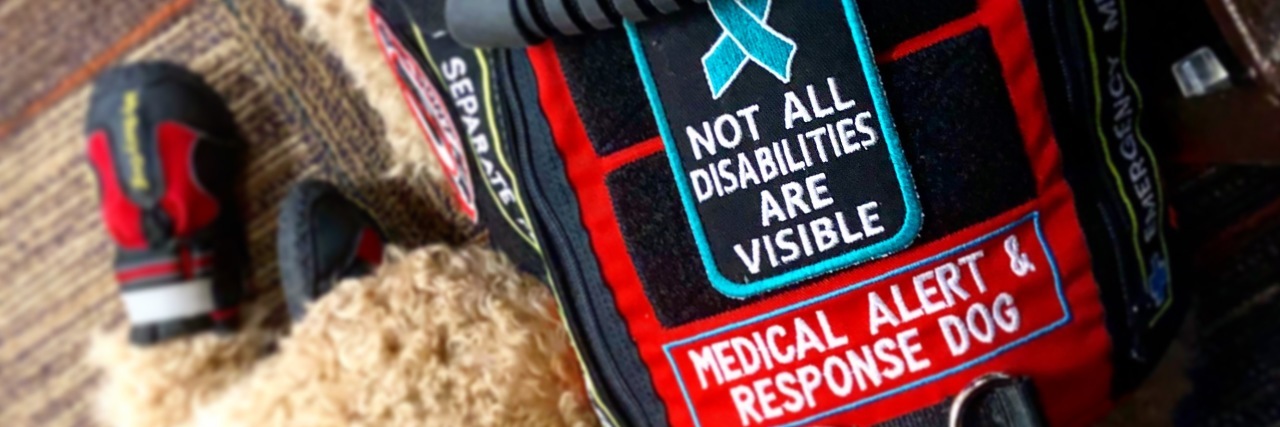An employee at our condo building recently saw me while I was waiting at the elevator with my daughter’s service dog. When the dog looked at him, he said: “What’re you doing looking at me? You’re working for her.” As he walked away, he muttered, “Service dog, my foot.” I’m not sure whether I was supposed to hear that or not, but since I did, I strongly voiced in his direction, “He is!”
Here’s what I wish I could tell him.
You probably don’t know much about service dogs. You probably know little or nothing about disabilities. You, your family and friends probably don’t have a disability or disabilities that prevent them from going through their activities of daily living without worrying what the next five hours or five minutes might bring. Do you know anything about anaphylaxis of unknown origin? That’s when your whole body fights against itself and your throat swells up and closes so that you can no longer breathe. A sudden attack of tachycardia? That’s a racing heart, the feeling you get when your adrenaline kicks in and your body jumps into fight or flight mode. An unexpected syncope episode? That’s fainting for no apparent reason.
The dog you thought was a fake is trained to alert my daughter to all of these possibilities and more, so she can hopefully avoid them altogether. The dog you dismissed as a fraud has already saved her life multiple times. The dog you claimed was a pretender is continually learning more and more things he can do for her, like fetching her life-saving medications, laying with his weight on her to stabilize and ground her during vertigo attacks, staying by her side in crowds and leading her to exits when she is too dizzy or disoriented to do it on her own, and keeping watch behind her and alerting her to sounds she may not be able to hear (which, by the way, requires him to turn his head toward sounds). You can’t tell what a service dog is highly trained to do just by looking at them, and you can’t tell someone’s medical history just by looking at them.
My daughter wanted to go skiing today, a sport she has loved since she was a really little girl. She is now 26 years old, and until a few short years ago she was almost like every other healthy 20-something young woman. Lots of unexplained things had happened health-wise over the years, but they didn’t all come together until she was diagnosed with not one, but many chronic illnesses, all invisible disabilities.
If you saw my daughter standing there with the dog instead of me, you probably would’ve said the same insensitive thing because she looks healthy. She looks like every other 20-something-year-old getting ready to hit the slopes. But that’s because you can’t see the PICC line under her right sleeve (a central line directly to her heart for intravenous medications), or the multitude of scars from so many procedures, surgeries and reactions. She looks like every other 20-something-year-old, except her body won’t let her get up in the morning – she literally cannot even drag herself out of bed many days because her body is so tired from always battling these invisible illnesses. I could tell you the names of them, but that wouldn’t help you understand. You’d probably think they were made up, too. My daughter looks like every other 20-something-year-old, beautiful and smart, fun and unassuming. But she’s not like every other 20-something-year-old woman. She lives with chronic illnesses, a host of invisible disabilities, every single day.
My daughter infused herself with IV fluids last night in anticipation of skiing today, took her 14 morning pills, packed herself an allergy-free lunch and her mid-day meds, and decided to ski with her sister and father. I’m so impressed that she does that, that she chooses fun over fatigue, that she chooses family togetherness over napping alone, that she chooses fight over defeat. Every day she makes these choices, but she certainly doesn’t owe an explanation to people like you. Because people like you might think you get it, but you really don’t. People like you who think they know what’s behind that Service Dog patch on the animal’s vest are the ones who make everyday even more difficult for people like my daughter.
Just because the dog turned his head to look at you doesn’t mean he’s not a highly-trained service dog. He is a dog after all, not a robot. And even service dogs are allowed to “look around.” I was caring for him this morning so that my daughter could be almost “normal” for just a few hours and go skiing – do something she loves with people she loves. Her wonderful, intelligent, beautiful service dog and I are just relaxing for a little while, waiting till she and her sister and her father come back from a gorgeous day on the slopes, and he can lovingly and carefully keep an eye on her for the rest of the day. Because he is a service dog — smart, intuitive and skillfully trained to greatly improve, and sometimes save, my daughter’s life.
So to your comment this morning I say: Service dog? Yes. Decent and understanding human being? My foot.

